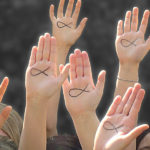There is a plague among us. It’s a mind-altering and highly contagious disease we are most susceptible to when we are young. It grows unnoticed, frequently for decades. It has a single name and a multitude of expressions.
This plague is called “the other.”
One symptom of infection is thinking that last sentence supports the discrimination, subjugation or terrorization of any “other.”
The sickness isn’t the actual other but is the perceived other. That’s an awfully philosophical sentence.
The disease isn’t the human being standing in front of us, behind us, beside us, above us or below us. The plague is our ideas about the human beings outside us.
How the plague grows
Part of the problem is our ideas about others are based on some seed—however small—of experience. It may be our own experience or the experience of others told to us. Either way, the experience is shaped by our own perception of it, which often is different from how others perceive it.
One person celebrated the forgiveness, the hug and the Bible given to Amber Guyger. Another person condemned the injustice of the sentence; another, the inappropriateness of Judge Kemp’s actions. The same experience is perceived differently along multiple lines. Differing narratives grow from different perceptions of one shared experience.
The seed grows to completely outstrip the original experience and becomes what we call a caricature or stereotype of the other.
The caricature takes on a life of its own. It seems so much more interesting than the truth, and so we settle for relating to the caricature of the other in place of interacting with the real human being. It’s less complicated and feels safer.
Sign up for our weekly edition and get all our headlines in your inbox on Thursdays
The plague feeds on supposed opposites
Consider some of the ways we think we are opposite of each other:
- Ford and Chevrolet
- Windows and Mac
- Cowboys and Redskins or Eagles
- Men and women
- Old and young
- Rural and urban, country and city
- Poor and rich
- Unions and bosses, workers and CEOs
- Democrats and Republicans
- Conservatives and liberals
- Whites and blacks, or any non-white person
- Citizens and immigrants and refugees
- Christians and Muslims
- Gay and straight
- Us and them
The list can go on for days. We have so many ways we separate ourselves from and oppose ourselves to others.
They don’t look like us, act like us, smell like us. They don’t eat like us, love like us, govern like us. We don’t understand them or like them. We’re afraid they will infect us, gain on us and take what is ours.
As long as we deal with a caricature of them, we don’t have to deal with how the real human being is very much like us. Their likeness to us seems to scare us more than their difference from us.
The Christian response to the plague
The Bible’s story tells us we are much more alike in fundamental ways than we are different.
“Let us make mankind in our image, in our likeness … So God created mankind in his own image, in the image of God he created them; male and female he created them” (Genesis 1:26-27).
We can caricature each other all we want, but we can’t take the image of God out of one another. Every single one of us shares this one thing: We all bear God’s image.
“For all have sinned and fall short of the glory of God …” (Romans 3:23).
We can caricature each other all we want, but we can’t alter our appearance so much as to make ourselves look better than any other. Every single one of us shares this one thing: We all bear the stench of sin.
“… and all (who believe) are justified freely by his grace through the redemption that came by Christ Jesus” (Romans 3:22, 24).
We can caricature each other all we want, but we can’t erase the saving work of Jesus Christ. Not a single one of us accomplished his work, and not a single one of us can take it away.
There’s no loophole in the Bible’s story. There’s no dehumanizing the other so that God’s image and Jesus Christ’s redemption don’t apply but sin does. All three together are the fundamental likeness we all share.
Going back to the list of supposed opposites
The word “and” in each dichotomy above—and all other dichotomies—is shorthand for the three fundamentals of the Bible’s story:
- All humans bear God’s image.
- All humans bear sin.
- Jesus justifies and redeems all who believe in him.
To eradicate the plague among us, we need to build our stories about each other, our experiences of each other and our relationships with each other on “and.”
Eric Black is the executive director, publisher and editor of the Baptist Standard. He can be reached at [email protected] or on Twitter at @EricBlackBSP. The views expressed are those solely of the author.















We seek to connect God’s story and God’s people around the world. To learn more about God’s story, click here.
Send comments and feedback to Eric Black, our editor. For comments to be published, please specify “letter to the editor.” Maximum length for publication is 300 words.